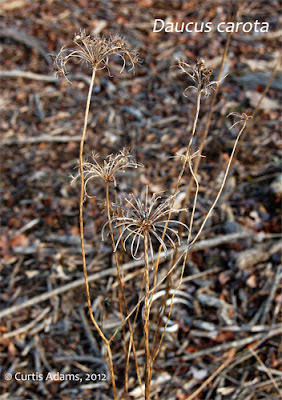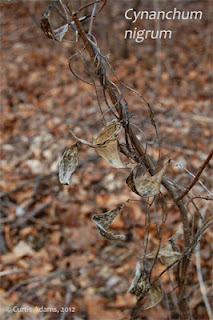 |
| The burrs on this Burdock catch the afternoon sun as easily as they do to a passing hiker. |
Next I walked by a thicket rich with Red Twig Dogwood. I am assuming these are the native Cornus sericea (formerly, C. stolonifera), even with leaves and flowers some of these species are difficult to tell apart.
.jpg) |
| The Red-twig Dogwood was easily identified among all the other brown branches in the thicket. |
Large sections of Rock Meadow are consistently wet. These areas are easily identified by their large populations of Cattails. There are two common species in the Northeast, one with broad leaves and one with narrow (Typha latifolia and T. angustifolia, respectively). I did not investigate which was present, or if both were there.
 |
| One of the wet areas in Rock Meadow that is home to Cattails |
 |
| Steeple Bush, just upstream of a wet meadow. |
While not a true pre-Colombian native species, Queen Anne's Lace has become naturalized throughout North America. Even without its flower petals, this plant still has a presence in the winter landscape.
 |
| The bare bones of Queen Anne's Lace |
 |
| The few remaining seeds on this Little Bluestem still catch the winter sunlight. |
Little Bluestem is a widespread native grass. It seems to look its best growing on really poor soils and is often seen growing along the highway. In richer soils it gets tall and floppy. In the fall and winter it can be picked out by its orangy appearance and the way that the fuzzy seeds catch the light.
One plant I almost passed right by was this Tower Mustard. It just looked like some sticks poking out of the ground. On closer examination I noticed the dimpled membranes that once held the seed in an alternating pattern. I didn't know this plant at first, but I looked in my copy of 'Weeds in Winter' and it led me to the mustard family. After that, I was able to locate the species by referring to my copy of Newcomb's.
 |
| The seed pods of Tower Mustard still show the impressions of the seeds they held. |
 |
| The opened seed pods of Evening Primrose look like dried flowers. |
Evening Primrose is a plant that is easy to recognize in its dried form. When I walked by I realized that I knew this plant, I just could not remember its name. The stiff, four-parted seed capsules on the tall, upright stems are unique and hard to forget. I quickly flipped through the field guide until I found a drawing that matched this plant dead on.
.jpg) |
| I'm pretty sure this is Sweet Everlasting. Had I used my nose as well as my eyes I would no for sure. |
As I moved into a shadier area, a large patch of Raspberry vines became evident. These stood out as a purple mass of branches against an otherwise dull brown background. Closer examination showed the little red thorns on the purple branches. A couple of years ago I attempted to ID some raspberries but was quickly overwhelmed by the possibilities. Right now I will just appreciate their contrast to the shades of brown.
 |
| Raspberries of some sort; the thorns are too small to be Blackberry |
 |
| When I first saw these berries I thought this might be an Arailia of some sort. A little research indicated that this was actually Carrion-Flower. |
While Rock Meadow has been cleaned up of many of its invasive species, some still remain. In the winter months Winged Euonymus is easily recognized by the little wing-like projections along its stems. Another common invasive is Black Swallowwort. It can be recognized by the remains of its seed pod that looks like a dried leaf. This vine is very hard to eradicate since it will resprout from small fragments of roots left behind after pulling or digging.
 |
| The arrow in the photo points to some of the wings on this Winged Euonymus. |
 |
| The old seed pods on this Black Swallowwort looks kind of like those of Milkweed. In fact these are both members of the Asclepiadaceae family. |






1 comment:
I have really been enjoying the recent posts on winter identification. of native plants. This is actually very helpful and is an aspect of plant ID that not many folks consider.
Thanks!
Post a Comment